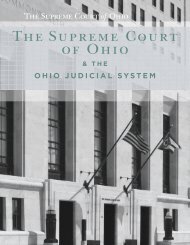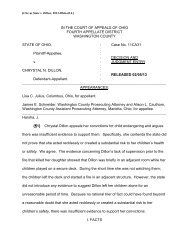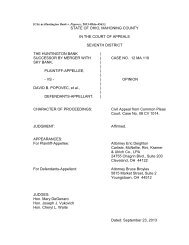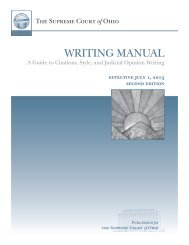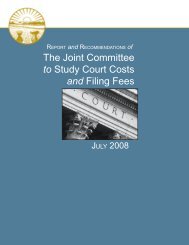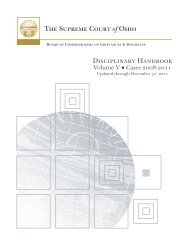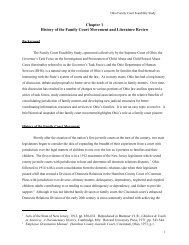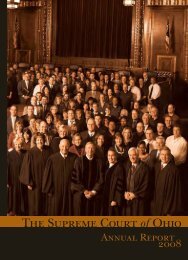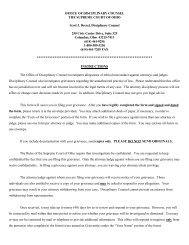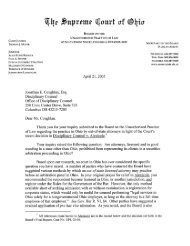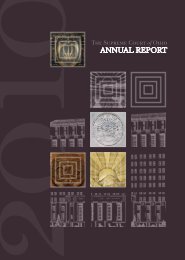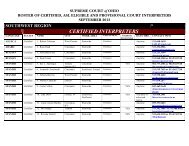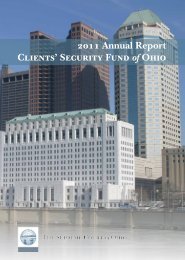richard r. rieck - Supreme Court
richard r. rieck - Supreme Court
richard r. rieck - Supreme Court
You also want an ePaper? Increase the reach of your titles
YUMPU automatically turns print PDFs into web optimized ePapers that Google loves.
[Cite as N. Olmsted v. Rieck, 2011-Ohio-1557.]<br />
<strong>Court</strong> of Appeals of Ohio<br />
EIGHTH APPELLATE DISTRICT<br />
COUNTY OF CUYAHOGA<br />
JOURNAL ENTRY AND OPINION<br />
No. 94905<br />
CITY OF NORTH OLMSTED<br />
vs.<br />
PLAINTIFF-APPELLEE<br />
RICHARD R. RIECK<br />
JUDGMENT:<br />
AFFIRMED<br />
Criminal Appeal from the<br />
Rocky River Municipal <strong>Court</strong><br />
Case No. 09-CRB-0843<br />
DEFENDANT-APPELLANT<br />
BEFORE: Celebrezze, J., Boyle, P.J., and Sweeney, J.
RELEASED AND JOURNALIZED: March 31, 2011<br />
ATTORNEY FOR APPELLANT<br />
Thomas J. Escovar<br />
Steuer, Escovar, Berk & Brown Co., L.P.A.<br />
55 Public Square<br />
Suite 1475<br />
Cleveland, Ohio 44113<br />
ATTORNEYS FOR APPELLEE<br />
Michael Gordillo<br />
Prosecuting Attorney<br />
City of North Olmsted<br />
5200 Dover Center Road<br />
North Olmsted, Ohio 44070<br />
Judith P. Lipton<br />
Cody Launder (Certified Legal Intern)<br />
Milton A. Kramer Law Clinic Center<br />
Case Western Reserve School of Law<br />
11075 East Boulevard<br />
Cleveland, Ohio 44106<br />
FRANK D. CELEBREZZE, JR., J.:<br />
{ 1} Appellant, Richard Rieck, appeals from his 2009 conviction for<br />
violating a criminal protective order (“CPO”). Appellant argues that his<br />
conviction was against the manifest weight of the evidence and not supported<br />
by sufficient evidence. He also claims his sentence is contrary to law. After<br />
a thorough review of the record and law, we affirm.
{ 2} Appellant and Christine Mastanuono began a relationship after<br />
appellant had been a customer at Christine’s hair salon for about two months.<br />
As their relationship grew, appellant moved into Christine’s home for a time.<br />
After a dispute, the couple broke up, appellant moved out, and, according to<br />
Christine, appellant engaged in a pattern of harassing and abusive behavior.<br />
Christine sought and received a CPO from Berea Municipal <strong>Court</strong> on April<br />
15, 2009. The CPO required appellant to stay at least 500 feet away from<br />
Christine, to not contact her, and to leave immediately if he should<br />
accidentally encounter her. 1<br />
{ 3} Appellant was indicted on four counts of violating a CPO<br />
pursuant to R.C. 2919.27. The case proceeded to a hearing before a<br />
magistrate on October 29, 2009. Christine testified that on April 22, 2009,<br />
she pulled into a BP gas station in North Olmsted, Ohio. She went inside<br />
the store to purchase a few items and emerged to find appellant, seated in his<br />
sister’s car, stopped near the door of the store. Upon seeing her, appellant<br />
smiled. She hurriedly walked to her car and drove away. She stated she<br />
felt scared. She immediately drove to a Middleburg Heights police station<br />
where she was told she must go to a North Olmsted police station, which she<br />
did.<br />
1 The CPO advised appellant that if he “accidentally comes in contact with<br />
[Christine] in any public or private place, [he] must depart immediately.”
{ 4} Appellant testified that he pulled into the gas station to buy a<br />
pack of cigarettes while on the way to his mother’s house a short distance<br />
away. Upon pulling into the lot, he saw Christine exit the store, and he<br />
immediately left. He even stated that he “peeled out,” and returned later to<br />
buy a pack of cigarettes and to apologize to the gas station attendant working<br />
behind the counter for peeling out.<br />
{ 5} The gas station attendant, Russell Lynch, testified that appellant<br />
was inside the store when Christine was inside and that upon seeing her,<br />
appellant left the store, returned to his car, and waited for between two and<br />
five minutes before leaving. Lynch stated that appellant returned about an<br />
hour later and made some disparaging remarks about Christine, which Lynch<br />
thought was strange. A few days later, appellant returned to the gas station<br />
and asked Lynch if the police had been there and what Lynch had told them.<br />
Lynch characterized appellant’s demeanor as arrogant and condescending.<br />
{ 6} Officer Jennifer Hayner of the North Olmsted police testified that<br />
she investigated the allegation that appellant had violated a CPO by going to<br />
the gas station and talking to Lynch. Lynch conveyed his recollection of the<br />
events that day, including appellant returning to the store later in the<br />
evening.<br />
{ 7} Officer Hayner followed up with appellant and his sister, Beth<br />
Flemming. Officer Hayner also investigated three hang-up phone calls
Christine had received and determined that they came from Flemming’s<br />
home, where appellant was staying. Flemming had originally told Officer<br />
Hayner that appellant was home when she left for work that day, but at trial,<br />
testified that appellant usually left for work before she did and that she was<br />
90 percent sure appellant was gone at the time the first call was placed.<br />
{ 8} At the close of trial, the magistrate found appellant not guilty of<br />
the three counts related to the phone calls, but guilty of one count related to<br />
the incident at the BP station. This decision was reviewed by a judge, and<br />
on March 4, 2010, was adopted by the court.<br />
{ 9} Appellant was sentenced to a 20-day jail term with ten days<br />
actual incarceration and 36 days of house arrest, a $1,000 fine, court costs,<br />
and four years of community control. Appellant filed for a stay of execution<br />
of sentence with both the trial court and this court, both of which were<br />
denied. Appellant timely appeals, citing two assignments of error.
Law and Analysis<br />
Sufficiency and Manifest Weight<br />
{ 10} Appellant first argues that his conviction is against the<br />
sufficiency and manifest weight of the evidence. Whether the evidence is<br />
legally sufficient to sustain a verdict is a question of law. State v. Robinson<br />
(1955), 162 Ohio St. 486, 124 N.E.2d 148. A conviction based on legally<br />
insufficient evidence constitutes a denial of due process. Tibbs v. Florida<br />
(1982), 457 U.S. 31, 45, 102 S.Ct. 2211, 72 L.Ed.2d 652, citing Jackson v.<br />
Virginia (1979), 443 U.S. 307, 99 S.Ct. 2781, 61 L.Ed.2d 560.<br />
{ 11} Where there is substantial evidence upon which the trier of fact<br />
has based its verdict, a reviewing court abuses its discretion in substituting<br />
its judgment for that of the trier of fact as to the weight and sufficiency of the<br />
evidence. State v. Nicely (1988), 39 Ohio St.3d 147, 156, 529 N.E.2d 1236.<br />
{ 12} The weight to be given the evidence and the credibility of the<br />
witnesses are primarily for the trier of fact to determine. State v. DeHass<br />
(1967), 10 Ohio St.2d 230, 231, 227 N.E.2d 212. On review, the appellate<br />
court must determine, after viewing the evidence in a light most favorable to<br />
the prosecution, whether any rational trier of fact could have found the<br />
essential elements of the crime proven beyond a reasonable doubt. State v.<br />
Jenks (1991), 61 Ohio St.3d 259, 273, 574 N.E.2d 492; Jackson v. Virginia,<br />
supra.
{ 13} Sufficiency of the evidence is subjected to a different standard<br />
than is manifest weight of the evidence. Article IV, Section 3(B)(3) of the<br />
Ohio Constitution authorizes appellate courts to assess the weight of the<br />
evidence independently of the factfinder. Thus, when a claim is assigned<br />
concerning the manifest weight of the evidence, an appellate court “has the<br />
authority and duty to weigh the evidence and to determine whether the<br />
findings of * * * the trier of facts were so against the weight of the evidence as<br />
to require a reversal and a remanding of the case for retrial.” State ex rel.<br />
Squire v. Cleveland (1948), 150 Ohio St. 303, 345, 82 N.E.2d 709.<br />
{ 14} The United States <strong>Supreme</strong> <strong>Court</strong> recognized the distinction in<br />
considering a claim based upon the manifest weight of the evidence as<br />
opposed to sufficiency of that evidence. The court held in Tibbs v. Florida,<br />
supra, that, unlike a reversal based upon the insufficiency of the evidence, an<br />
appellate court’s disagreement with the jurors’ weighing of the evidence does<br />
not require special deference accorded verdicts of acquittal, i.e., invocation of<br />
the double jeopardy clause as a bar to relitigation. Id. at 43.<br />
{ 15} Upon application of the standards enunciated in Tibbs, the court<br />
in State v. Martin (1983), 20 Ohio App.3d 172, 485 N.E.2d 717, has set forth<br />
the proper test to be utilized when addressing the issue of manifest weight of<br />
the evidence. The Martin court stated: “The court, reviewing the entire<br />
record, weighs the evidence and all reasonable inferences, considers the
credibility of witnesses and determines whether in resolving conflicts in the<br />
evidence, the jury clearly lost its way and created such a manifest<br />
miscarriage of justice that the conviction must be reversed and a new trial<br />
ordered.” Id. at 720.<br />
{ 16} In the present case, appellant was convicted of violating a<br />
criminal protective order granted pursuant to R.C. 2903.213. R.C.<br />
2919.27(A)(2) prohibits one from recklessly violating the terms of a protective<br />
order of the type at issue here. Appellant claims he abided by the terms of<br />
the order, and left immediately upon encountering Christine in a public place.<br />
The protective order in this case specifies that “Defendant shall stay away<br />
from protected person named in this order, and shall not be present within<br />
500 feet * * * of any protected person, wherever protected persons may be<br />
found, or any place the Defendant knows or should know the protected<br />
persons are likely to be, even with protected persons’ permission. If<br />
Defendant accidentally comes in contact with protected persons in any public<br />
or private place, Defendant must depart immediately. This order includes<br />
encounters on public and private roads, highways, and thoroughfares.”<br />
(Emphasis sic.)<br />
{ 17} Appellant testified that upon seeing Christine, he immediately<br />
left, and therefore did not violate the terms of the CPO. However, Christine<br />
testified that appellant was parked close to the entrance of the gas station
store when she exited and that he smiled at her. He did not immediately<br />
leave. Appellant points to her testimony on cross-examination where she<br />
agreed with a question posed by appellant’s counsel that appellant<br />
immediately left. However, what Christine testified to during direct and<br />
cross-examination was that she did not see appellant pull into the gas station<br />
and only noticed him parked outside the doorway when she exited. She<br />
further testified that, upon seeing him, she put her head down, hurriedly<br />
walked to her car, and immediately drove to the police station because she<br />
felt scared and threatened. She did not see him leave.<br />
{ 18} This is not the only testimony the state produced at trial. Lynch,<br />
the gas station attendant, testified that appellant entered the store, saw<br />
Christine and left the building. He then saw appellant get into his car and<br />
wait. Lynch testified that appellant did not immediately leave, but was in<br />
the parking lot for possibly as long as five minutes before leaving. Lynch<br />
also testified that appellant returned to the station later and explained that<br />
he could not be in the same place as Christine and told Lynch to be careful<br />
what he said to Christine because she was crazy.<br />
{ 19} Coupled with Christine’s testimony, Lynch’s testimony indicates<br />
that appellant knew Christine was inside the store, but that he waited until<br />
Christine emerged from the store to depart. He did not immediately depart<br />
as required by the CPO. Therefore, his conviction is supported by sufficient
evidence. The unbiased testimony of a third-party employee of the gas<br />
station indicates that appellant lingered in the gas station parking lot even<br />
after he knew Christine was inside.<br />
{ 20} This same testimony demonstrates that there was no miscarriage<br />
of justice in this case. The magistrate and trial court reviewed the evidence<br />
and testimony and came to the well-supported conclusion that appellant<br />
violated the terms of the CPO.<br />
Sentence Contrary to Law<br />
{ 21} Appellant finally takes issue with the sentence imposed by the<br />
trial court, stating that “[t]he trial court incorrectly sentenced [him] to jail<br />
and an unreasonably harsh punishment in direct conflict with the overriding<br />
purpose for punishment contemplated in section 2929.11 and 2929.12 of the<br />
Ohio Revised Code. Further, said punishment was based inappropriately on<br />
assumptions taken by the trial court which were irrelevant erroneous, other<br />
cases which had been dismissed.”<br />
{ 22} In this assignment of error, appellant cites to sentencing<br />
provisions dealing with felony sentencing, which are inapplicable to this case.<br />
R.C. 2929.21(A) sets forth the overriding purposes of misdemeanor<br />
sentencing, including “to protect the public from future crime by the offender<br />
and others and to punish the offender. To achieve those purposes, the<br />
sentencing court shall consider the impact of the offense upon the victim and
the need for changing the offender’s behavior, rehabilitating the offender, and<br />
making restitution to the victim of the offense, the public, or the victim and<br />
the public.”<br />
{ 23} R.C. 2929.22(B)(1) offers a trial court guidance in crafting a<br />
sentence to comport with these touchstones. These factors include: “(a) The<br />
nature and circumstances of the offense or offenses; (b) Whether the<br />
circumstances regarding the offender and the offense or offenses indicate that<br />
the offender has a history of persistent criminal activity and that the<br />
offender’s character and condition reveal a substantial risk that the offender<br />
will commit another offense; (c) Whether the circumstances regarding the<br />
offender and the offense or offenses indicate that the offender’s history,<br />
character, and condition reveal a substantial risk that the offender will be a<br />
danger to others and that the offender’s conduct has been characterized by a<br />
pattern of repetitive, compulsive, or aggressive behavior with heedless<br />
indifference to the consequences; (d) Whether the victim’s youth, age,<br />
disability, or other factor made the victim particularly vulnerable to the<br />
offense or made the impact of the offense more serious; (e) Whether the<br />
offender is likely to commit future crimes in general, in addition to the<br />
circumstances described in divisions (B)(1)(b) and (c) of this section.”
{ 24} Post-Foster, 2 appellate courts should apply a two-step analysis in<br />
determining the validity of a sentence. State v. Kalish, 120 Ohio St.3d 23,<br />
2008-Ohio-4912, 896 N.E.2d 124, 4. 3 “First, they must examine the<br />
sentencing court’s compliance with all applicable rules and statutes in<br />
imposing the sentence to determine whether the sentence is clearly and<br />
convincingly contrary to law. If this first prong is satisfied, the trial court’s<br />
decision shall be reviewed under an abuse-of-discretion standard.” Id. To<br />
constitute an abuse of discretion, the ruling must be unreasonable, arbitrary,<br />
or unconscionable. Blakemore v. Blakemore (1983), 5 Ohio St.3d 217, 450<br />
N.E.2d 1140.<br />
{ 25} Appellant first argues that the trial court’s imposition of a jail<br />
term is an affront to the principles of sentencing. Appellant’s violation of<br />
R.C. 2919.27 is a misdemeanor of the first degree and is punishable by a jail<br />
term of up to 180 days. R.C. 2929.24(A)(1). House arrest, four years of<br />
community control, alcohol and drug treatment, and a $1,000 fine are also<br />
within the bounds provided for in R.C. 2929.25(A)(1)(b) and (A)(2) for a first<br />
degree misdemeanor. Therefore, they are clearly not contrary to law.<br />
{ 26} The trial court considered the pattern of harassment appellant<br />
had engaged in, including his admitted filing of harassing complaints with<br />
2 State v. Foster, 109 Ohio St.3d 1, 2006-Ohio-856, 845 N.E.2d 470.<br />
3 We recognize that Kalish is a plurality opinion, but it is instructive.
the state boards of cosmetology and health; two complaints for money<br />
appellant alleged Christine owed, but which were later dismissed; and the<br />
posting of flyers about sexually transmitted diseases on the window of her<br />
salon. Officer Hayden testified that appellant told her that even after the<br />
CPO was issued, he still drove past Christine’s salon even though it took him<br />
within 500 feet of her. He said he should not have to change his route<br />
because of the CPO. This evidence speaks to the factors set forth in R.C.<br />
2929.22(B)(1)(b) and (c) above.<br />
{ 27} Appellant argues that he did not have a chance to review the<br />
presentence report (“PSI”) and to investigate any inaccuracies contained<br />
therein. The report in this case was described as a police sentence report<br />
and was orally presented by community control officer Judy Nash. It<br />
contained a summary of an interview with appellant, Christine’s victim<br />
impact statement, and a summary of the history between appellant and<br />
Christine and their various legal conflicts.<br />
{ 28} Appellant complains that information from other court<br />
proceedings was improperly used at sentencing, including several hundred<br />
text messages introduced in a prior stalking case that was ultimately<br />
dismissed. However, this history may be properly considered by the court in<br />
crafting appellant’s sentence as demonstrating whether the “offender’s
conduct has been characterized by a pattern of repetitive, compulsive, or<br />
aggressive behavior.” R.C. 2929.22(B)(1)(c).<br />
{ 29} R.C. 2929.22(D)(1) states that “[a] sentencing court shall consider<br />
any relevant oral or written statement made by the victim, the defendant, the<br />
defense attorney, or the prosecuting authority regarding sentencing for a<br />
misdemeanor. This division does not create any rights to notice other than<br />
those rights authorized by Chapter 2930. of the Revised Code.” (Emphasis<br />
added.) Appellant claims that the state was required to present him with a<br />
copy of a PSI for review prior to the sentencing hearing. Appellant cites to<br />
no statute or case law to support this proposition. R.C. 2951.03(B)(1) does<br />
require this procedure in the case of felony sentencing where a PSI is<br />
required. Here, however, we have a misdemeanor sentence, where R.C.<br />
2929.22(D)(1) specifies that use of such a statement does not give appellant<br />
any right to notice outside of Chapter 2930 of the Revised Code.<br />
{ 30} R.C. 2930.13, states in pertinent part that a victim impact<br />
statement “may include the following: (1) An explanation of the nature and<br />
extent of any physical, psychological, or emotional harm suffered by the<br />
victim as a result of the crime * * *; (2) An explanation of the extent of any<br />
property damage or other economic loss suffered by the victim as a result of<br />
that crime * * *; (3) An opinion regarding the extent to which, if any, the<br />
victim needs restitution for harm caused by the defendant * * * as a result of
that crime * * *; (4) The victim’s recommendation for an appropriate sanction<br />
or disposition for the defendant or alleged juvenile offender regarding that<br />
crime or specified delinquent act.” Here, nothing in the victim impact<br />
statement falls outside of the allowed materials specified above. Also, the<br />
victim impact statement is not required to be disclosed to a defendant prior to<br />
sentencing. State v. Wallace, Richland App. No. 2002CA0072,<br />
2003-Ohio-4119, 17, citing State v. Stewart, 149 Ohio App.3d 1,<br />
2002-Ohio-4124, 775 N.E.2d 563. “‘Just because a victim impact statement is<br />
included in a PSI does not mean that a defendant will have access to it.’” Id.,<br />
quoting Stewart at 4. See, also, R.C. 2951.03(B).<br />
{ 31} R.C. 2930.14 also specifies that if the victim’s statement “includes<br />
new material facts, the court shall not rely on the new material facts unless it<br />
continues the sentencing or dispositional proceeding or takes other<br />
appropriate action to allow the defendant or alleged juvenile offender an<br />
adequate opportunity to respond to the new material facts.”<br />
{ 32} Here, Christine alleged that she lost her business because of<br />
appellant’s constant harassing behavior and that she had to move out of the<br />
area to get away from appellant. While these were new material facts, the<br />
trial court gave appellant an opportunity to respond. Appellant argued that<br />
Christine lost her business because of financial difficulties that resulted in<br />
her declaring bankruptcy, not because she had to move away to avoid him.
Appellant was given an opportunity to respond and did respond to these<br />
allegations. Further, appellant never requested additional time to respond,<br />
but made arguments during the sentencing hearing addressing these new<br />
facts.<br />
{ 33} Appellant’s sentence is not contrary to law, nor does it constitute<br />
an abuse of discretion. The trial court was presented with a pattern of<br />
behavior that included vexatious reports to regulatory authorities and a<br />
demonstrated disregard for the protective order. The trial court did not err<br />
in crafting appellant’s sentence.<br />
Judgment affirmed.<br />
It is ordered that appellee recover from appellant costs herein taxed.<br />
The court finds there were reasonable grounds for this appeal.<br />
It is ordered that a special mandate issue out of this court directing the<br />
Rocky River Municipal <strong>Court</strong> to carry this judgment into execution. The<br />
defendant’s conviction having been affirmed, any bail pending appeal is<br />
terminated. Case remanded to the trial court for execution of sentence.<br />
A certified copy of this entry shall constitute the mandate pursuant to<br />
Rule 27 of the Rules of Appellate Procedure.<br />
FRANK D. CELEBREZZE, JR., JUDGE<br />
MARY J. BOYLE, P.J., and
JAMES J. SWEENEY, J., CONCUR



